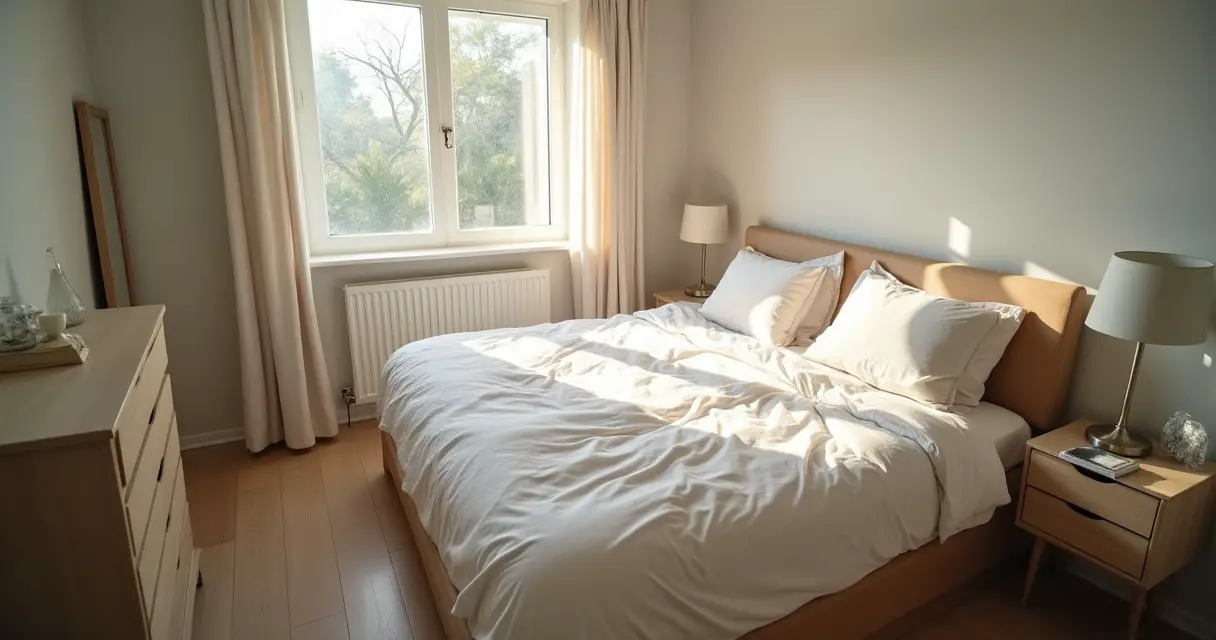Can we just talk for a moment about why everyone gets “cozy” wrong?
It’s one of my biggest pet peeves. People think cozy is an additive process. They see a picture online, they buy the chunky knit blanket, the 17 throw pillows, the Faux Fur rug, and they just… pile it on. I once walked into a new client’s primary bedroom, and it felt less like a sanctuary and more like a high-end storage unit for a home goods catalog. The visual noise was so loud I could barely think.
Here’s the secret the best designers understand: Cozy isn’t an inventory of soft things. It’s an outcome. It’s the feeling of security and tranquility that comes from a series of deliberate, strategic choices. It’s about subtraction as much as addition. It’s about light, texture, and flow. It’s about creating a space where your nervous system can finally downshift.
So, let’s cut through the noise. Forget mindlessly adding more stuff. I’m going to walk you through the real framework for building a bedroom that feels like a warm embrace—a systematic approach that ensures every single element serves the ultimate goal of deep, lasting comfort.
Designing Your Cozy Haven: The Foundational Steps (Part 1)
Before you touch a single paint swatch or browse for bedding online, we have to lay the groundwork. So many people skip this part because it feels like homework, but I promise you, this is where the magic happens. Getting the foundation right is the difference between a room that looks cozy in a photo and one that actually feels serene to live in. This is the architecture of comfort, and it’s non-negotiable.
1. Assess Your Current Bedroom Vibe for Transformation Potential
Before you can chart a course, you need to know where you are. Stand in the doorway of your bedroom and take a deep breath. How does it honestly make you feel? Stressed? Rested? Overwhelmed? Don’t just look at it; conduct a sensory audit. What do you hear? The hum of the air conditioning, traffic outside? What do you feel underfoot? Cold hardwood or a soft rug? Your body is giving you crucial data.
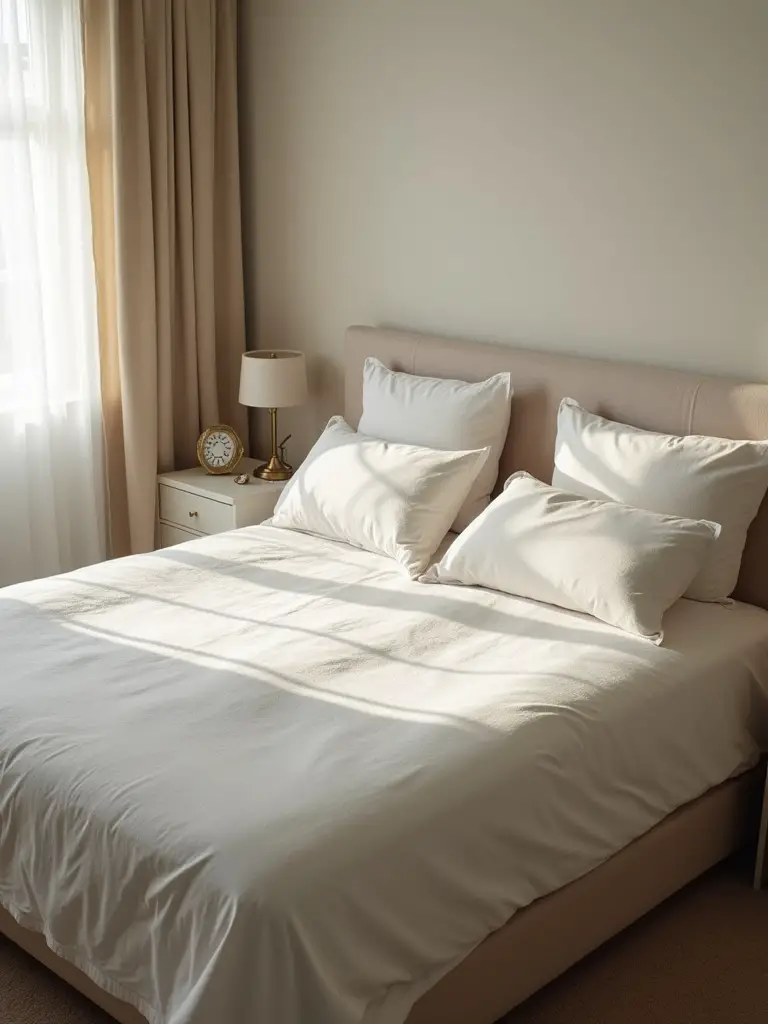
The shortcut I give all my clients is to photograph the room from every angle. A photo is brutally honest in a way our eyes aren’t—it flattens the space and forces you to see the clutter, the awkward flow, the jarring colors you’ve trained yourself to ignore. This isn’t about judgment; it’s about diagnosis. The most expensive mistake you can make is to start buying things before you’ve pinpointed the real problems.
2. Define Your Cozy Aesthetic: Mood Boarding Warmth and Calm
I know, “mood board” sounds a bit cliché, but here’s where people go wrong: they use it for collection, not for curation. A mood board’s real power is as a filter. Go ahead and pin everything that whispers “sanctuary” to you on Pinterest. But then comes the crucial step: edit ruthlessly. Look for the common threads. Are you consistently pinning rooms with dark, moody walls? With light, airy linen? With warm wood tones?
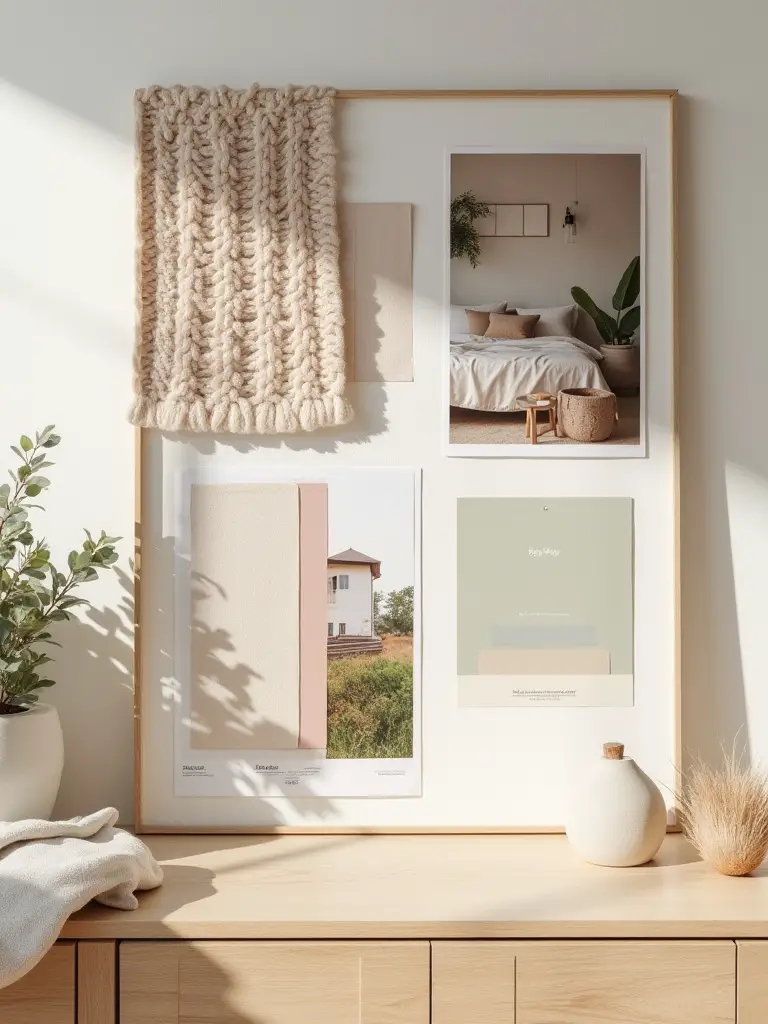
Your goal isn’t a board with 500 pretty pictures. Your goal is a board with 15-20 images that tell a cohesive story. This edited vision becomes your North Star. A client once came to me completely overwhelmed, and we spent the first hour of our consultation just deleting 90% of her pins. Suddenly, her true aesthetic—a serene, slightly rustic modernism—was crystal clear. Your mood board isn’t the pile of ingredients; it’s the final recipe.
3. Optimize Layout for Intimacy: Bed Placement & Flow Strategies
The position of your bed is the single most important decision you will make in your bedroom. This isn’t just about aesthetics; it’s about your primal brain. You want the head of your bed against a solid wall, ideally in a position where you have a clear sightline to the door without being directly in front of it. We are hardwired to feel safer when we can see a potential entrance, and that feeling of security is the very foundation of relaxation.
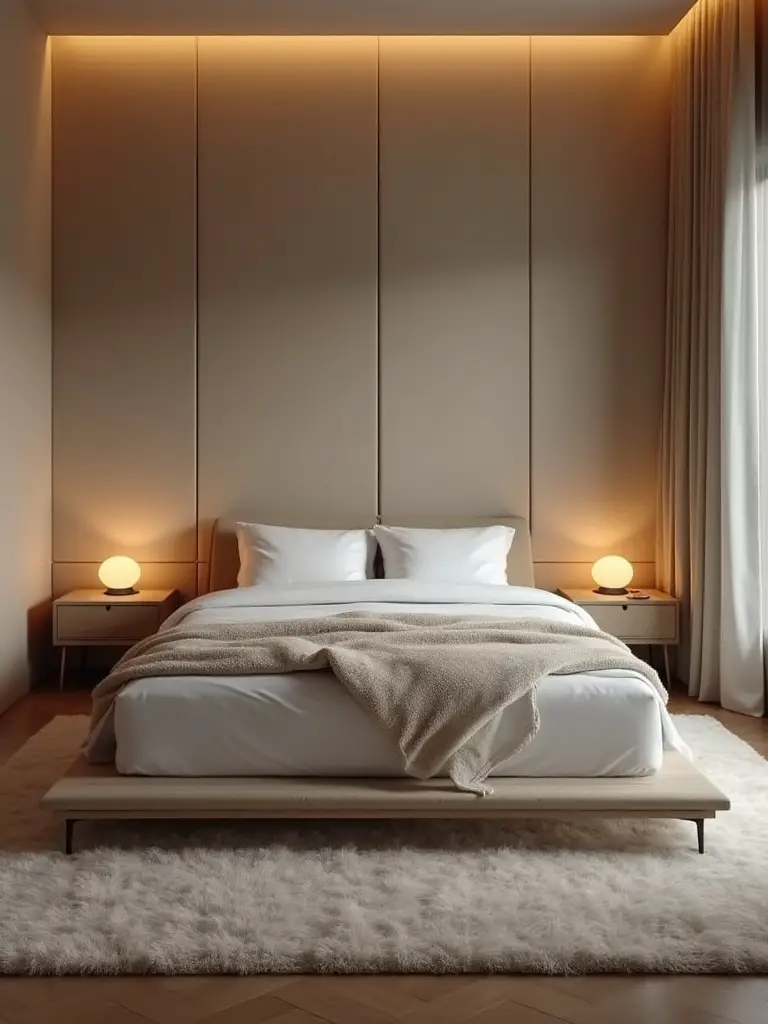
Please, stop pushing your bed into a corner to “save space.” It creates a cramped, dorm-room feeling and is deeply impractical for one of the sleepers. The ultimate luxury is flow. You need at least 24-30 inches of walking space on either side of the bed. My trick? Use painter’s tape to mark out the footprint of your bed and other furniture on the floor. Live with it for a day. You’ll know instantly if the layout feels generous or constricted without having to move a single heavy object.
4. Strategically Declutter for a Visually Relaxing Space
You knew this was coming. But let’s reframe it. This isn’t just about “tidying up.” It’s about creating “visual silence.” Your bedroom is the one place your brain should not be asked to process a to-do list. That pile of unsorted mail, the exercise equipment, the basket of unfolded laundry—each one is a silent, visual nag that keeps your mind humming with low-grade stress.
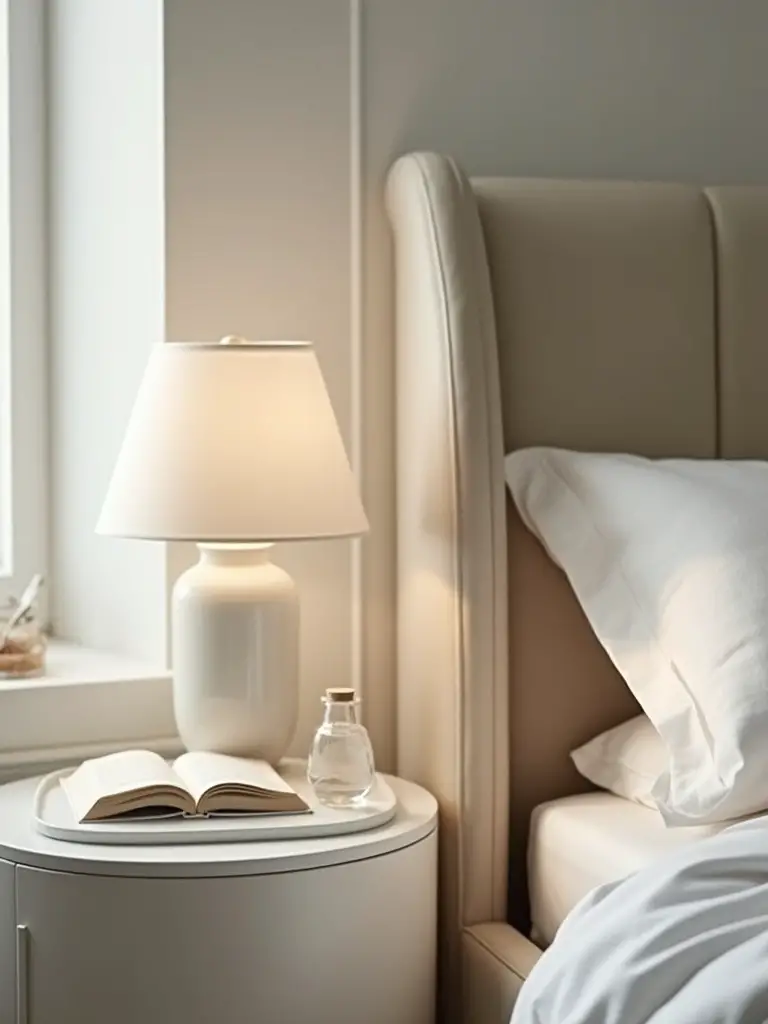
Your mission is to make sure every single object in your bedroom serves one of two purposes: function or joy. And the functional items, like charging cables or lotions, should have a designated, hidden home. Closed storage is your best friend. A client of mine claimed her life changed when she moved her home office setup—just a laptop and a stack of papers—from her bedside table into the living room. She said it was like an invisible weight lifted, allowing her to finally unplug. That’s the power of creating a true sanctuary.
With our foundation set, we can now turn to the element that most profoundly and immediately impacts the mood of a room. It’s the backdrop for everything we will add later. I’m talking, of course, about color.
Designing Your Cozy Haven: The Foundational Steps (Part 2)
This is where the room truly begins to take on its personality. Color is deeply psychological, and the right palette can physically soothe your nervous system, creating an atmosphere of instant calm before you even add a single piece of furniture.
5. Choose a Soothing Color Palette for Instant Calm
Forget color trends. What was the “Color of the Year” has absolutely no bearing on your personal sanctuary. What matters is science. Colors in the blue, green, and muted neutral families have been shown to lower blood pressure and slow respiration. They are inherently calming to our biology. Think of deep mossy greens, misty blues, soft greiges, or even warm, dusky mauves. These colors envelop you rather than jolt you.
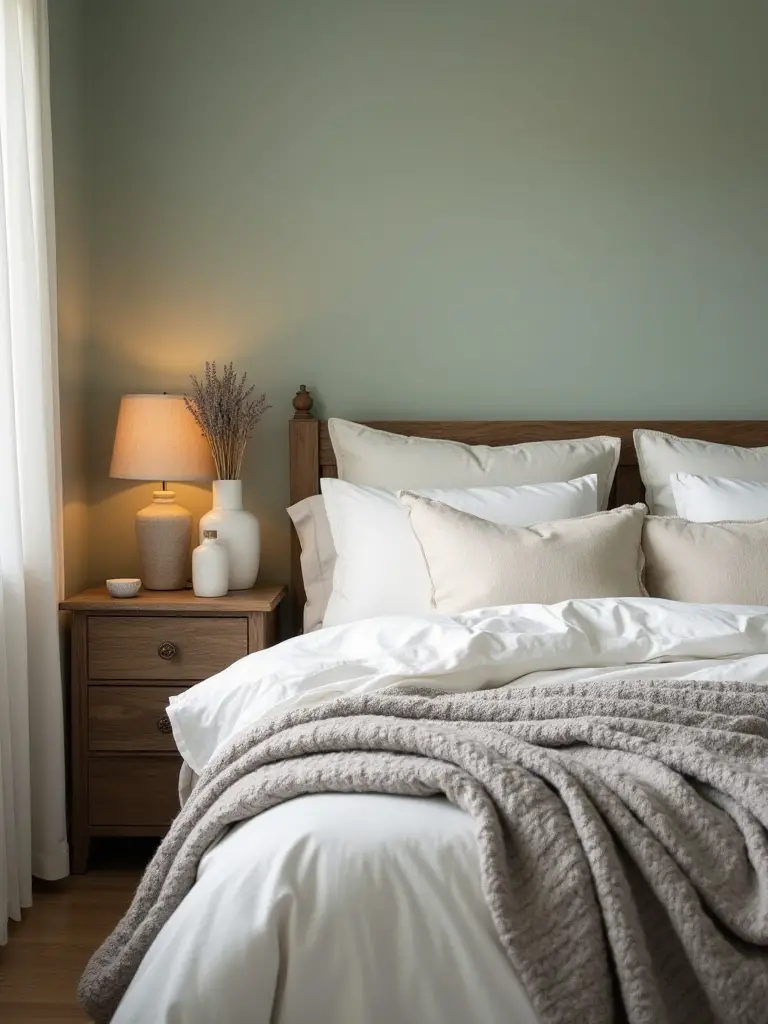
But here is the single most important piece of advice I can give you: never, ever choose a paint color from a tiny chip under the fluorescent lights of a hardware store. It’s design malpractice. You must buy sample pots and paint large (at least 2′ x 2′) swatches on several different walls in your room. Watch them throughout the day. The color that looks perfect in the morning sun might look sickly under your evening lamps. The light in your room is the secret ingredient, and testing the paint in situ is the only way to get it right.
Now that we’ve established the structure and the mood with our layout and color, it’s time to bring in the core elements. These are the pieces that provide tangible comfort—the furniture and textiles you will interact with every single day. This is where you invest.
Curating Core Comfort Elements: Furnishing Your Retreat (Part 1)
This stage is about building layers of tactile and visual comfort. We’re moving from the abstract plan to the physical experience. These are the foundational pieces that define your bedroom’s purpose: to be a haven for rest and relaxation.
6. Invest in Plush Bedding Layers for Cloud-Like Comfort
You spend roughly one-third of your life in bed. If there is one place in your home to make a serious investment, this is it. Creating that cloud-like, hotel-level comfort is about strategic layering. Start with a quality mattress topper—it’s a game-changer. Then, focus on natural, breathable fibers for your sheets: Egyptian cotton, linen, or bamboo. They regulate temperature and feel incredible against your skin.

The visual “poof” comes from a well-sized duvet. Your duvet should be generous, draping over the sides of the mattress by at least a foot. A skimpy duvet is one of the fastest ways to make a bed look cheap. Finally, add your textural layers: a quilt or coverlet, a folded throw at the foot of the bed, and your sleeping pillows propped against two larger Euro shams. It’s a formula that creates depth and an irresistible invitation to dive in.
7. Incorporate Soft Textiles with Varied Textures: Throws & Rugs
A room with only hard surfaces will always feel cold and echoey, no matter the color on the walls. Textiles are the key to absorbing sound and adding softness. The most critical textile is a large area rug. It needs to be big enough to extend at least 24 inches on either side of the bed, so your bare feet hit something plush and warm in the morning. This single act defines the sleep zone and immediately dials up the cozy factor by a hundred.
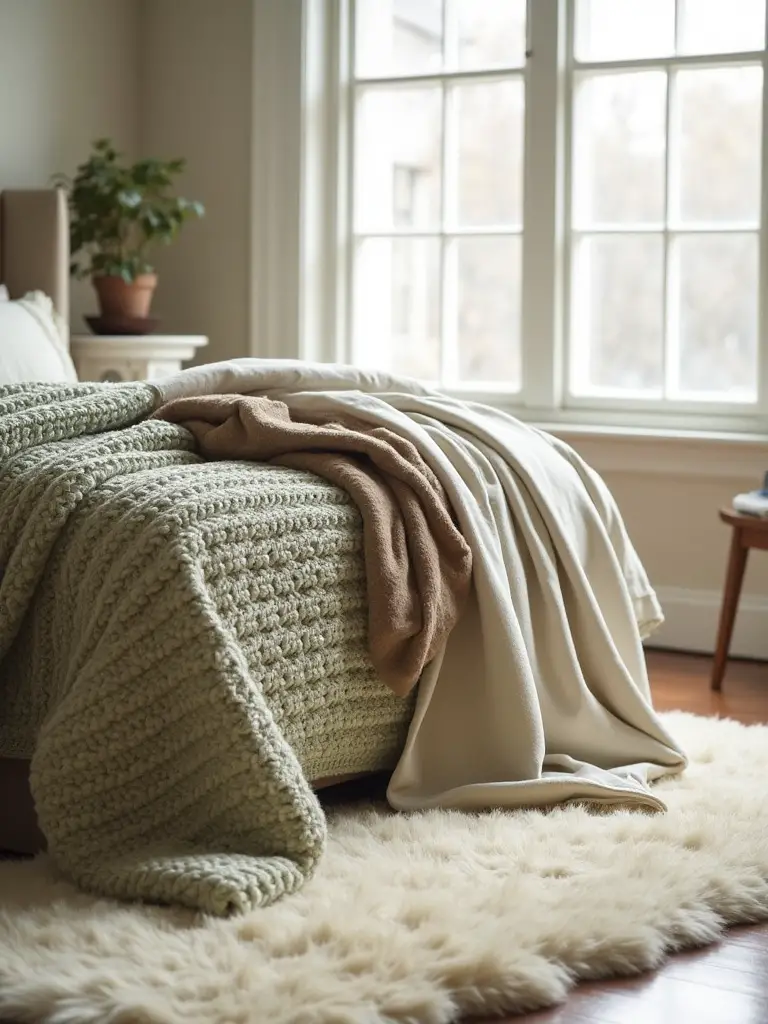
Beyond the rug, this is where you can play with throws and accent pillows. Mix your materials. If your headboard is upholstered in linen, add velvet pillows. If your bedding is smooth cotton sateen, drape a chunky knit throw over the end. The interplay of different textures—smooth, nubby, fuzzy, crisp—creates a rich, tactile experience that is the essence of sophisticated comfort.
8. Select Ambient Lighting Fixtures for Warm Glow
Get rid of the “big light.” That single, harsh overhead fixture is the enemy of intimacy and calm. Professional design is all about layered lighting. Your bedroom needs at least three sources of light: ambient (the overall glow), task (for reading), and accent (to highlight art or a specific corner). And every single one of them should be on a dimmer. A dimmer switch is the cheapest, most effective luxury upgrade you can possibly make.
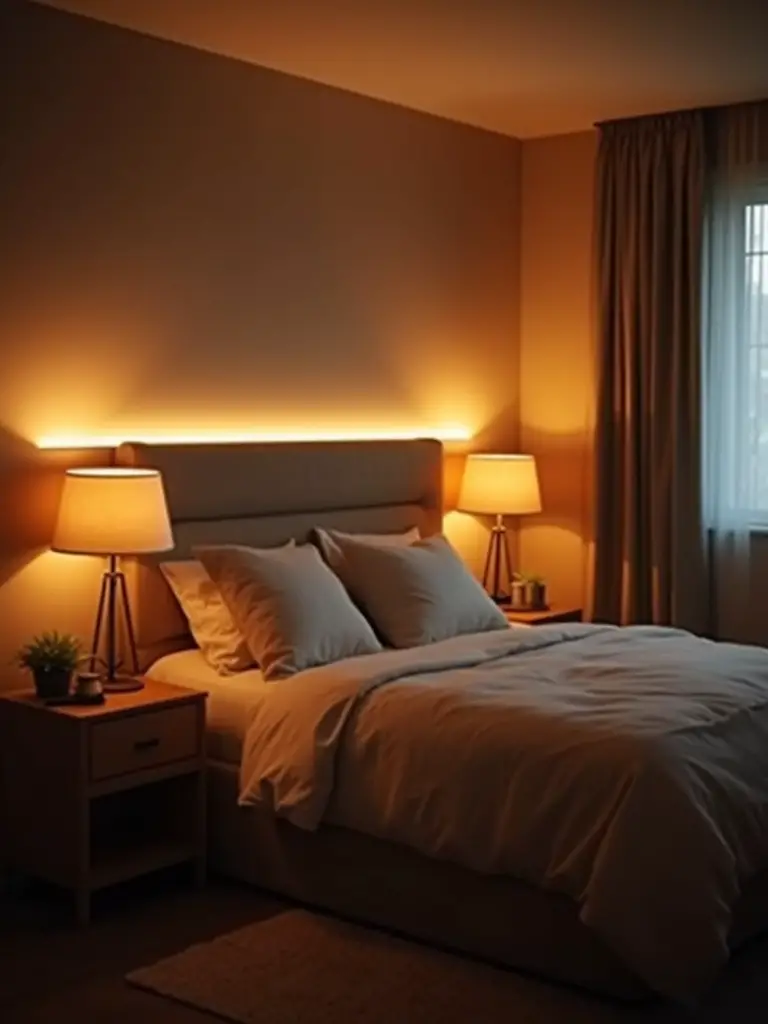
For your fixtures, choose pieces that diffuse light. Think linen drum shades, frosted glass sconces, or alabaster table lamps. And pay attention to your light bulbs. You want a warm Color temperature—around 2700K—which mimics the gentle glow of candlelight. It signals to your brain that it’s time to wind down, creating a serene and flattering atmosphere that no overhead light can ever replicate.
9. Add Natural Wood Furniture for Organic Warmth
In a world filled with synthetic materials, the grain and texture of natural wood bring a vital sense of organic warmth and life into a space. It’s a biophilic connection—our innate desire to be close to nature. A solid wood bed frame, a pair of walnut nightstands, or a reclaimed pine dresser can anchor the room and prevent it from feeling sterile.
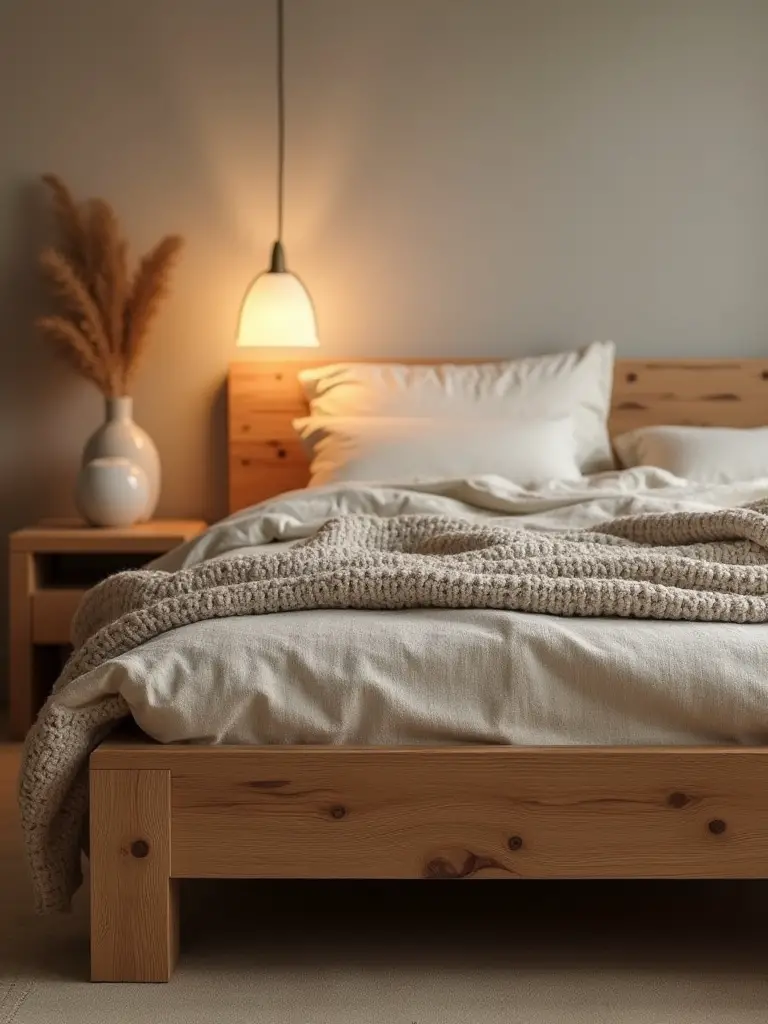
Don’t be afraid to mix wood tones, as long as they share a similar undertone (warm with warm, cool with cool). A beautiful piece of wood furniture is an investment. Its patina will only deepen with age, adding character and a timeless quality to your sanctuary. It has a soul that mass-produced particleboard simply cannot replicate.
With the main furnishings in place, we’re building an environment that feels solid and comforting. Next, we’ll address the crucial elements that control the room’s atmosphere, giving you the power to fine-tune your sanctuary for perfect rest, day or night.
Curating Core Comfort Elements: Furnishing Your Retreat (Part 2)
Here, we focus on the practicalities that deliver profound comfort. This is about taking control of your environment—mastering light and temperature to ensure your bedroom supports deep, uninterrupted sleep year-round.
10. Introduce Heavy Drapes or Blackout Blinds for Privacy and Darkness
Controlling light is essential for good sleep. Heavy drapes or blackout blinds are not just a design choice; they are a health and wellness tool. They provide absolute privacy, insulate against heat and cold (saving you money), and muffle outside noise. But most importantly, they create the cave-like darkness your body needs for optimal melatonin production.
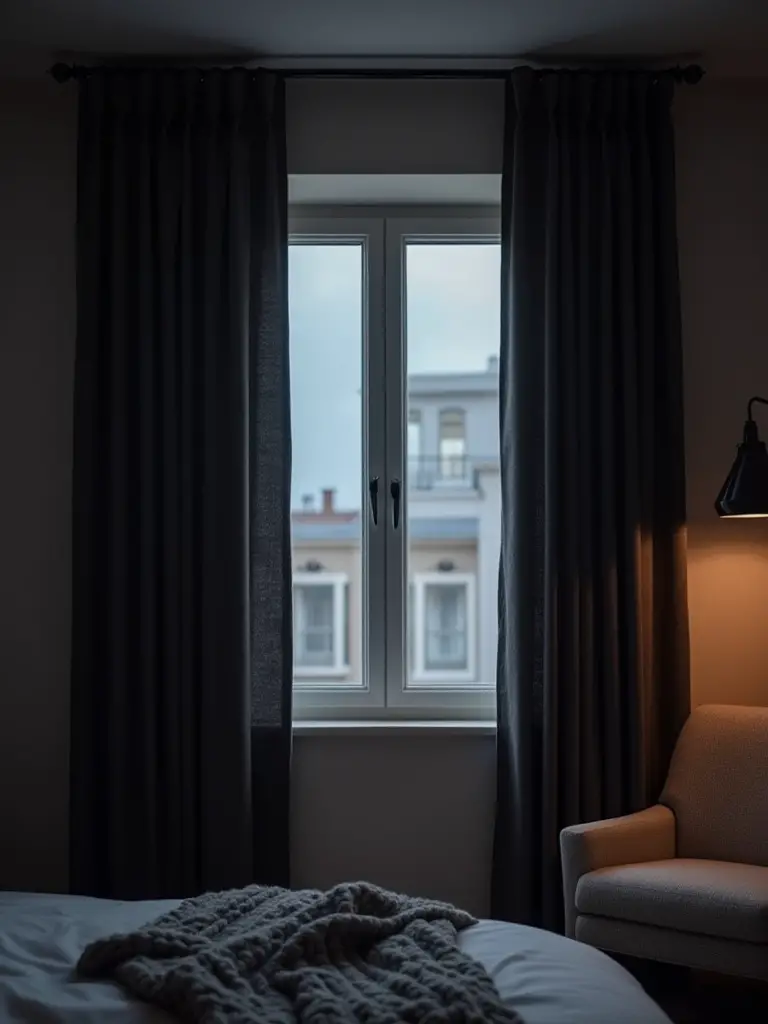
Here’s the professional trick: hang your curtain rod high and wide. Mounting it 6-12 inches above the window frame and extending it 8-12 inches on either side makes your window look larger and more majestic, and it ensures the drapes completely block light leaks when closed. Let the panels just “kiss” the floor. It’s a polished, custom look that elevates the entire room.
11. Optimize Temperature Control for Year-Round Comfort
The ideal sleep temperature is surprisingly cool—typically between 60 and 67 degrees Fahrenheit. An overheated room is a recipe for restless nights. Optimizing your room’s climate is a key part of creating a cozy haven, and it goes beyond just adjusting the thermostat.
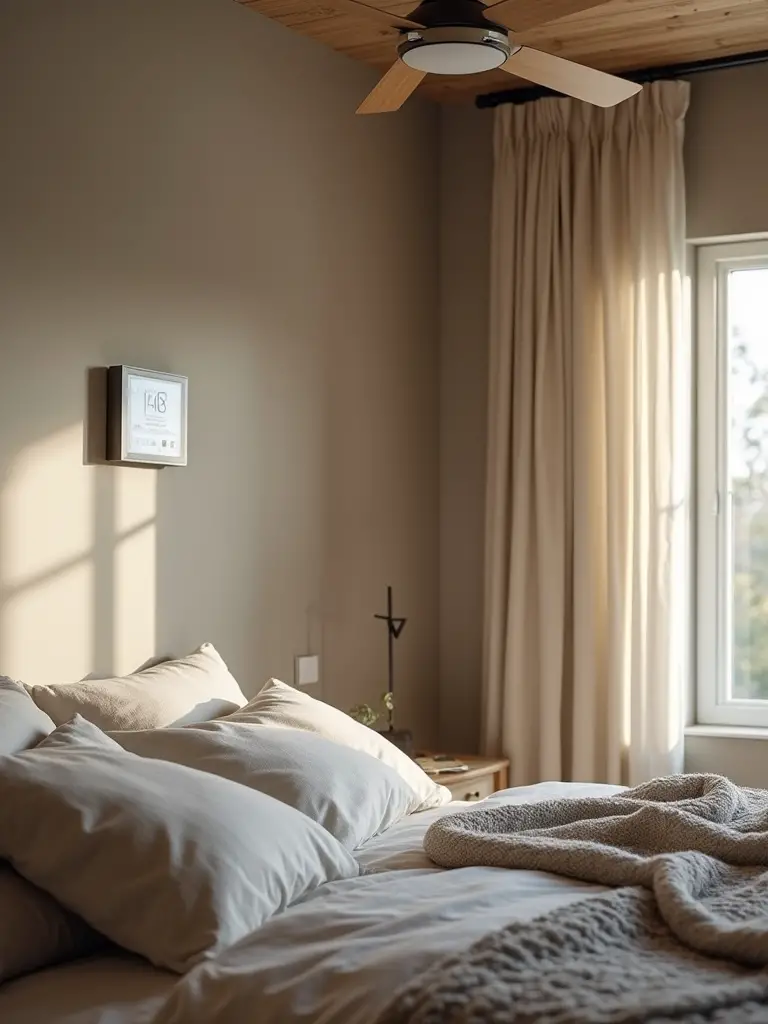
Invest in a smart thermostat that can be programmed to lower the temperature before bedtime. Consider a ceiling fan for gentle air circulation; in the winter, reverse the blade direction to push warm air down. And your bedding choices matter immensely. Have seasonal bedding sets: crisp, breathable linen or percale for summer, and cozy, insulating flannel or sateen for winter. This allows you to create your perfect microclimate for comfortable, year-round rest.
Our sanctuary is now fully furnished and functional. It’s comfortable, calm, and optimized for rest. Now, we get to the best part: making it uniquely yours. This next layer is all about personality and ambiance.
Enhancing Ambiance & Personal Touch: Styling Your Sanctuary (Part 1)
This is where your bedroom transforms from a well-designed space into a personal retreat. These details engage your other senses and infuse the room with your story, creating an environment that feels not just comfortable, but deeply resonant and soulful.
12. Integrate Scented Candles or Diffusers for Relaxing Aromas
Scent is the most underrated tool in design. It has a direct line to the parts of your brain that control memory and emotion. A signature scent for your bedroom—something like lavender, sandalwood, chamomile, or cedarwood—can become a powerful psychological cue for relaxation. When you smell it, your body will know it’s time to unwind.
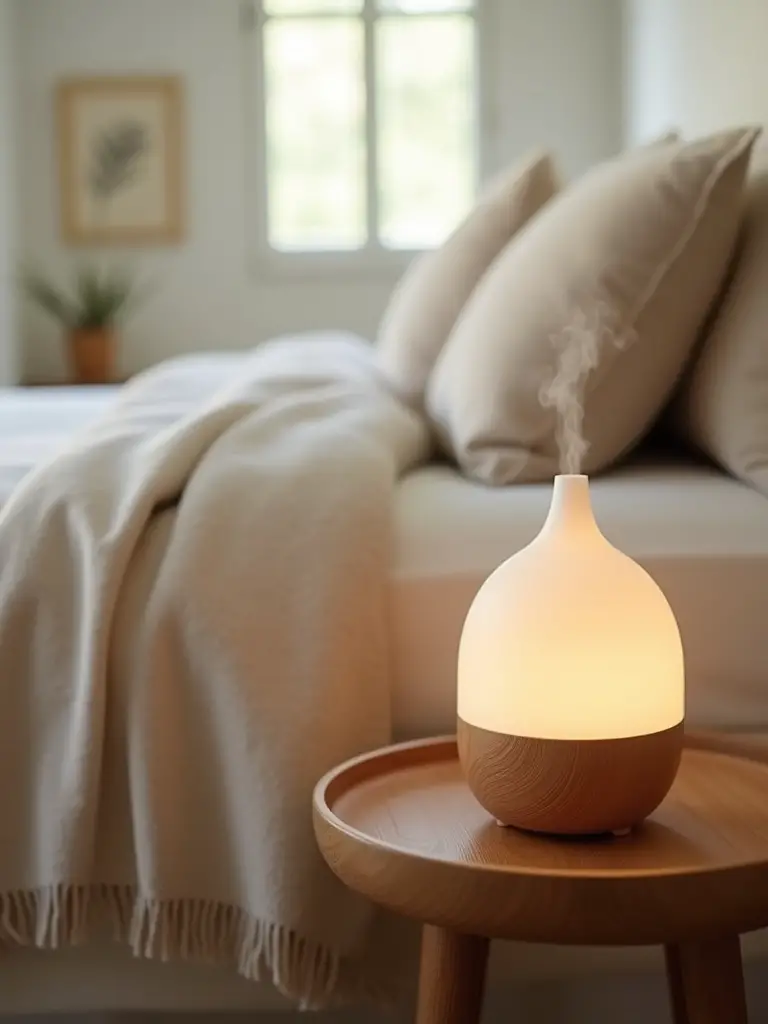
Whether you prefer the gentle flicker of a high-quality soy or beeswax candle or the constant, subtle release from an essential oil diffuser, make this a part of your pre-sleep ritual. A client of mine starts her diffuser an hour before bed, and she says by the time she enters her room, the scent alone makes her shoulders drop. It’s a small detail with a massive impact.
13. Style Cozy Reading Nooks with Comfortable Seating
If you have the space, carving out a dedicated reading nook is a profound act of self-care. It creates a “third space” in your room that isn’t the bed and isn’t a functional dresser—it’s a zone purely for quiet contemplation. All you need is a comfortable armchair, a small side table for a cup of tea, and excellent task lighting.
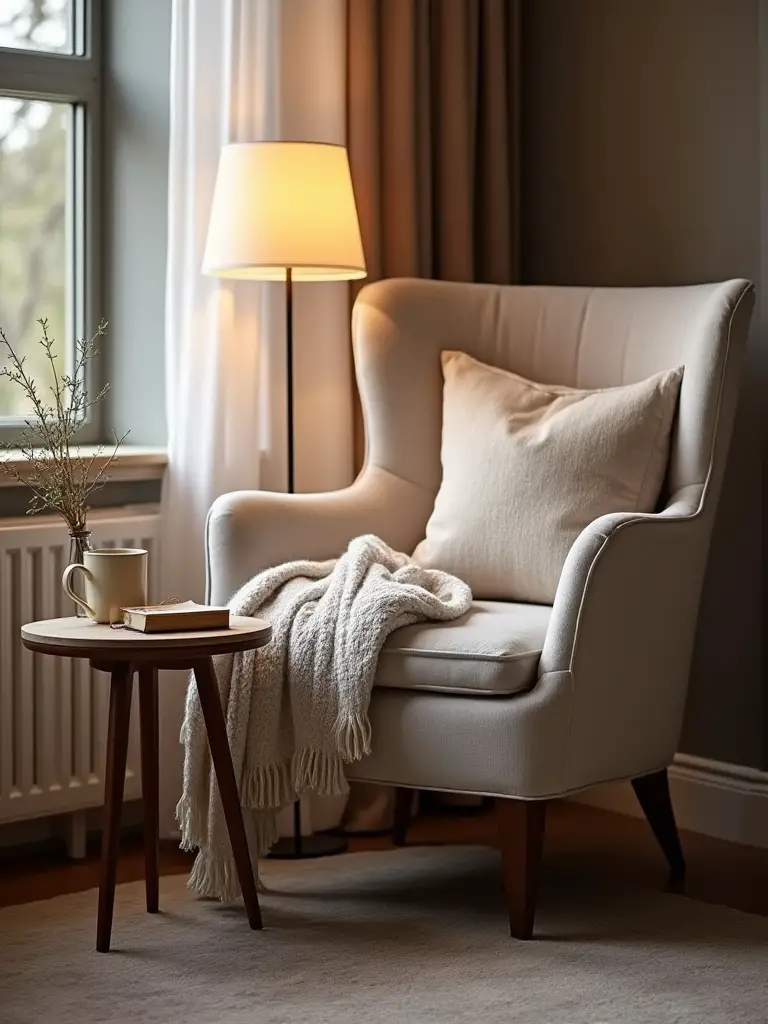
The chair is key. It needs to be something you can truly curl up in. Look for depth in the seat and comfortable arms. A soft throw blanket draped over the arm and a supportive lumbar pillow complete the invitation. This little corner encourages a healthy, screen-free wind-down routine, which is one of a designer’s best-kept secrets for better sleep.
14. Curate Wall Art & Mirrors to Reflect Serenity
Your walls should not be an afterthought. Art should evoke the feeling you want to have in the room. For a bedroom, think serene landscapes, calming abstracts, or soft black-and-white photography. One large, impactful piece over the bed can be more powerful than a cluttered gallery wall. The rule is simple: if it doesn’t make you feel peaceful, it doesn’t belong in your bedroom.
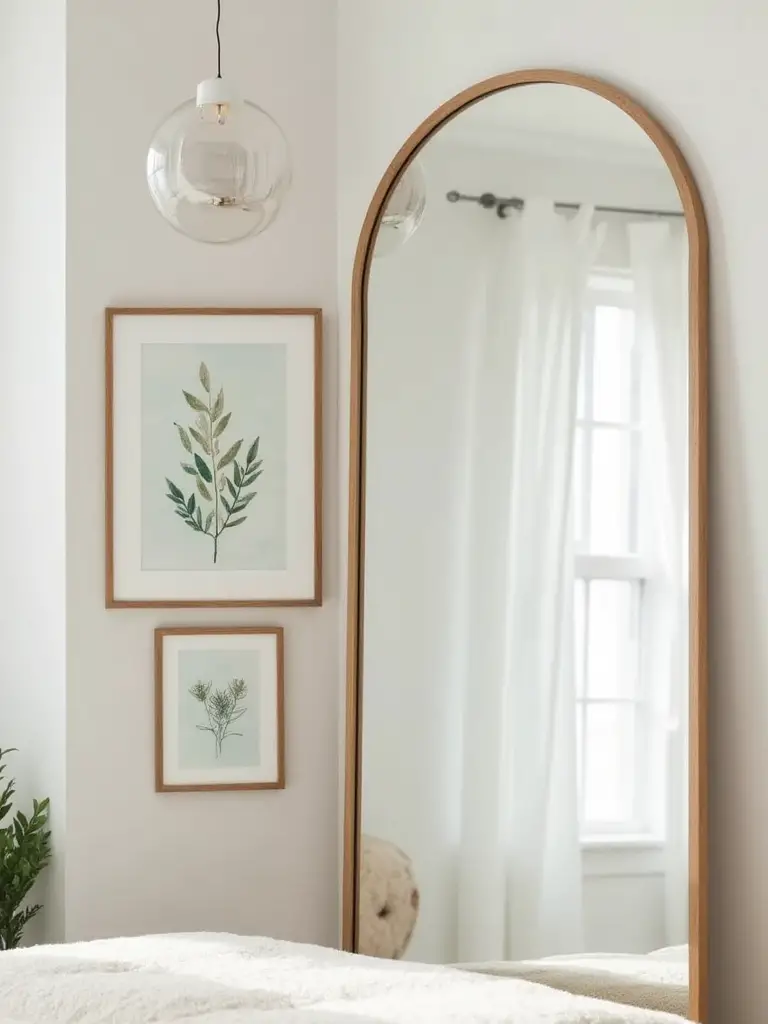
Mirrors are magic wands for light and space. A large mirror placed opposite a window will essentially “steal” the light and view, bouncing it around the room and making the entire space feel larger and brighter. A mirror with a beautiful frame—perhaps warm wood or soft-gilded metal—can even double as a piece of art itself.
15. Display Personal Mementos & Cherished Books
This is your sanctuary, and it should tell your story. But the key is curation. A few treasured items, displayed beautifully, feel personal and warm. A hundred of them just feel like clutter. Choose a small collection of objects that hold real meaning: a few photos in elegant frames, a beautiful ceramic dish from your travels to hold your rings, a small stack of your favorite, well-loved books.
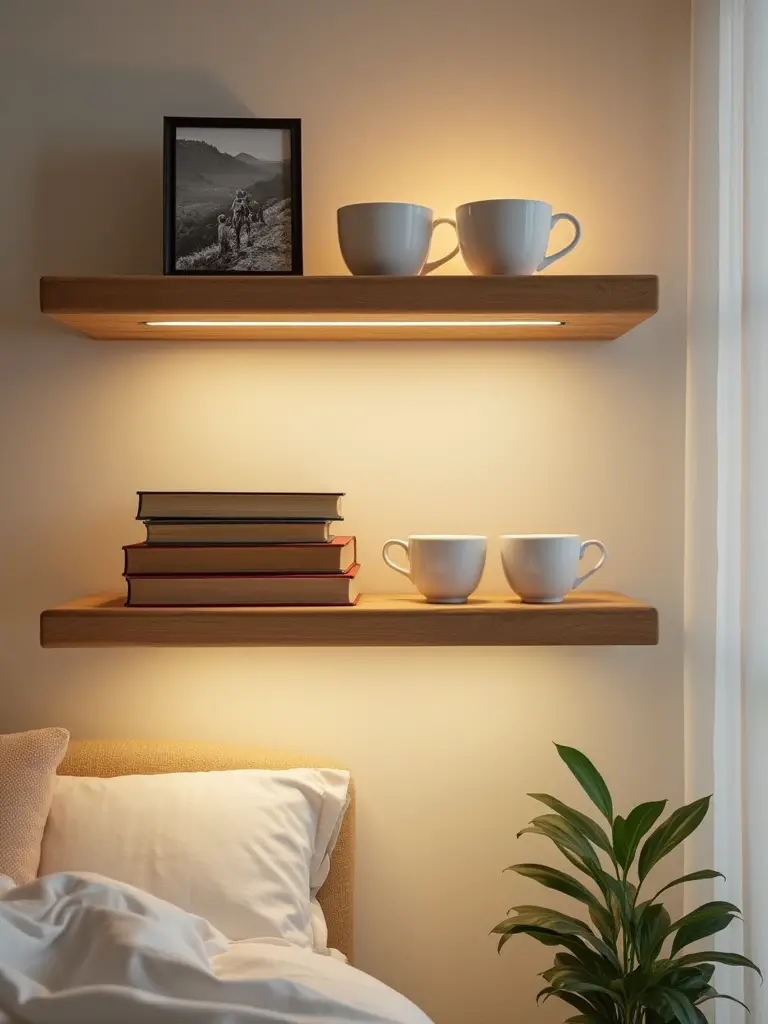
Use decorative trays to corral these items on a dresser or nightstand. This simple trick creates a “vignette” and makes a collection of small objects feel intentional and organized rather than random and messy. This isn’t a museum; it’s a living space infused with your personal history.
We are getting closer to a fully realized vision. The space now has a soul. The next steps are about adding life itself, bringing in elements from the natural world to complete our serene escape.
Enhancing Ambiance & Personal Touch: Styling Your Sanctuary (Part 2)
This final layer of styling is about infusing your room with vitality. It’s about bringing the outside in to purify your air and soothe your soul, bridging the gap between a curated space and a living, breathing sanctuary.
16. Introduce Live Plants for Natural Serenity and Air Purity
Every room feels better with something alive in it. Plants are the easiest way to add natural color, organic texture, and a touch of serenity. And they’re not just pretty; NASA research has shown that common houseplants are incredible at filtering toxins from the air, creating a healthier environment while you sleep.
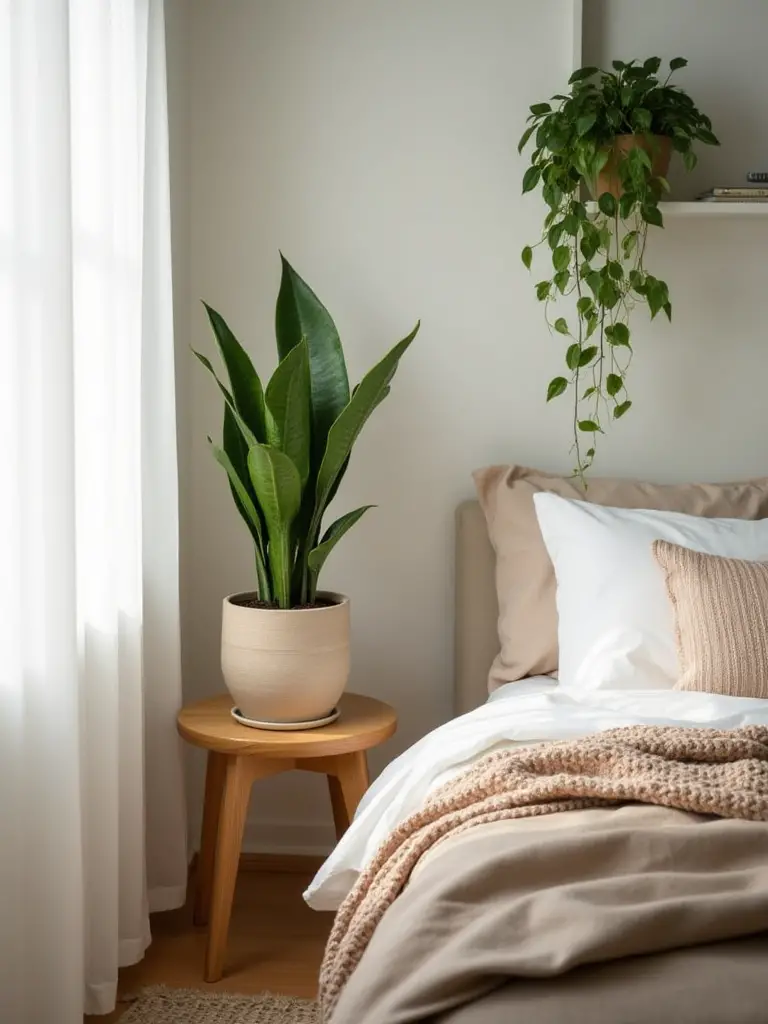
Choose low-maintenance plants that thrive in lower light, like snake plants, ZZ plants, or pothos. Even a single plant in a beautiful ceramic pot on your dresser can transform the feel of the room. It’s a simple addition that makes your space feel cared for, vibrant, and deeply connected to the natural world.
The design is complete. But a sanctuary isn’t a static project; it’s a space you live in and maintain. Our final section is about the habits and advanced touches that ensure your cozy retreat stays that way.
Maintaining the Cozy Charm: Daily Habits & Advanced Touches (Part 1)
This is about protecting your investment. You’ve created a beautiful space; now, let’s talk about the systems and invisible upgrades that keep it functioning as a peaceful haven day in and day out.
17. Implement Smart Storage Solutions to Keep Clutter Away
The best way to combat clutter is with brilliant storage. Think vertically with tall bookcases. Think multifunctionally with a storage bed or an ottoman with a hidden compartment. Use drawer dividers to bring order to the chaos inside your dressers and nightstands. The goal is to make it easy to put things away.
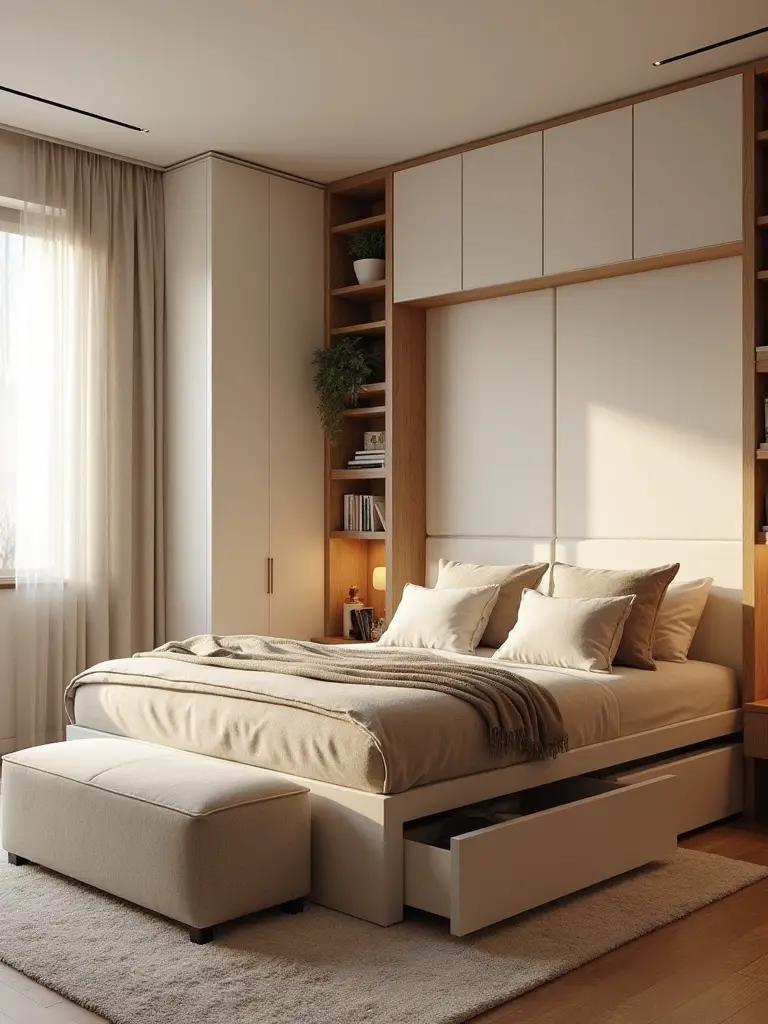
I swear by the “one-in, one-out” rule. When you buy a new sweater, an old one gets donated. It prevents the slow creep of accumulation. Smart, integrated storage isn’t about hiding your life; it’s about choreographing your daily routine so that maintaining a serene space feels effortless.
18. Create a Sleep-Optimized Environment: Tech-Free Zones
This may be the hardest, but most important, rule. Your bedroom should be a sanctuary for sleep and intimacy only. The blue light from our phones, tablets, and TVs actively suppresses melatonin, the hormone that tells your body it’s time to sleep. Scrolling in bed is sabotaging your rest.
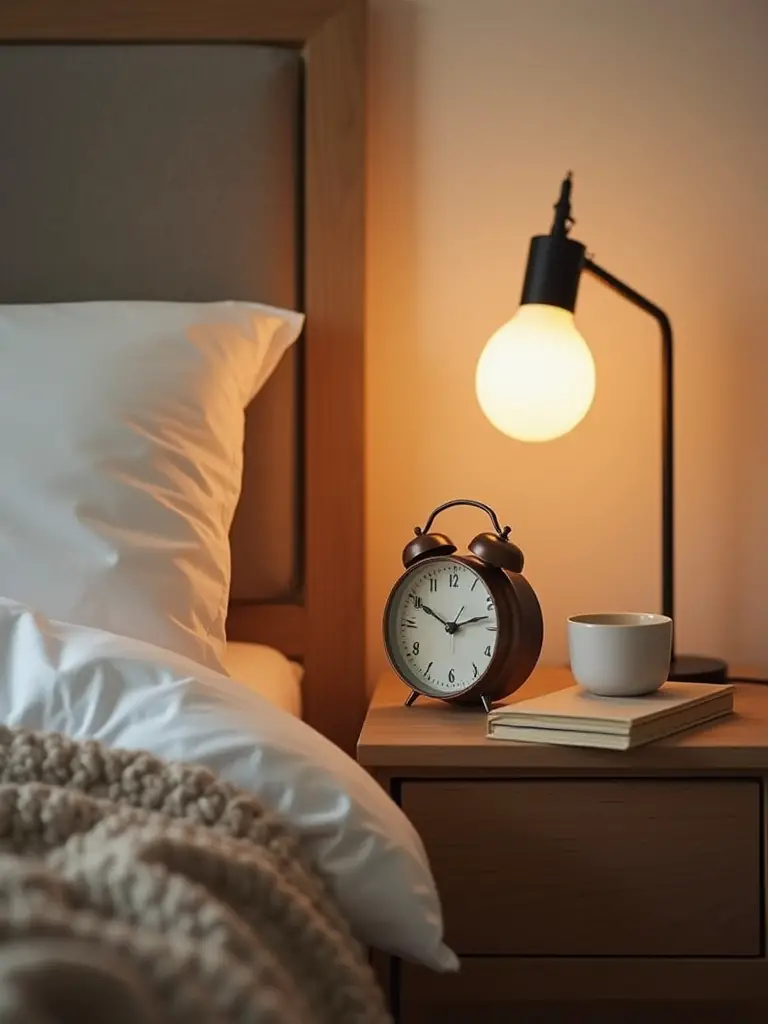
Create a charging station for all your electronics outside of the bedroom. Buy a simple, old-school alarm clock. I had a client who was a CEO and swore she couldn’t sleep without her phone nearby. After two weeks of leaving it in the kitchen overnight, she told me she hadn’t slept that well in a decade. The ultimate modern luxury isn’t the latest device; it’s the freedom to disconnect from it.
19. Consider Sound Dampening for Ultimate Tranquility
Silence is a texture. It’s an essential component of a luxurious, cozy space. You’ve already added sound-dampening textiles with your rug and drapes, but you can go further. An upholstered headboard is not only comfortable for reading but also fantastic at absorbing sound. Even a large canvas art piece can help reduce echo.
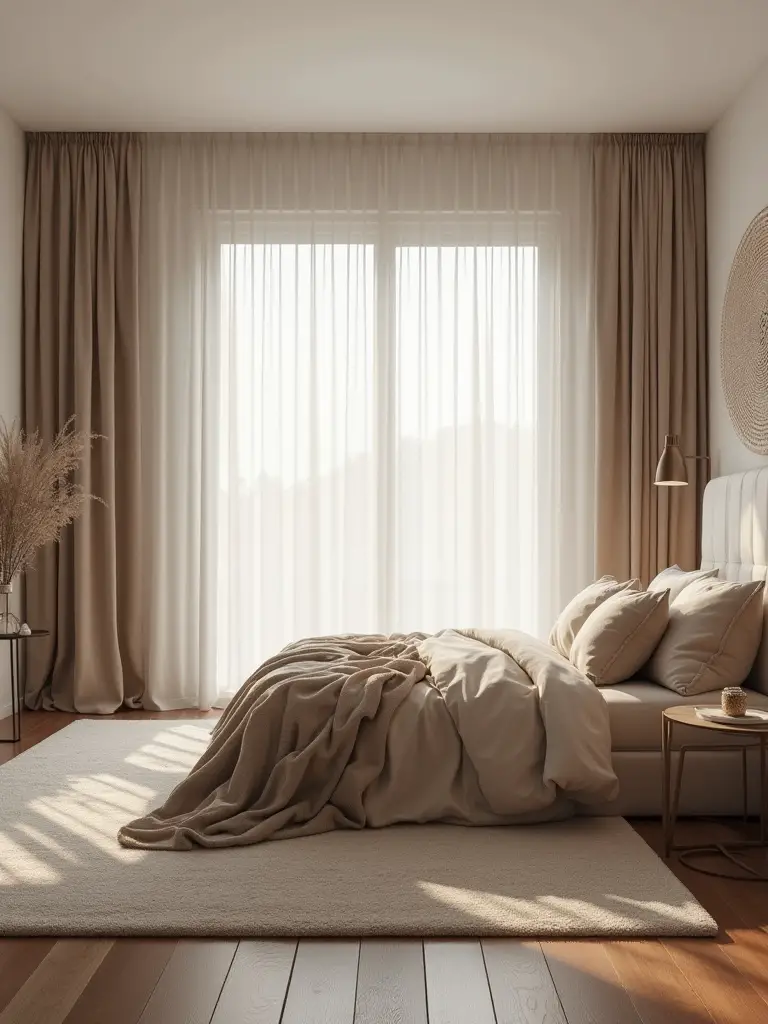
For city dwellers or light sleepers, a white noise machine can be a lifesaver. It creates a consistent, soothing sonic blanket that masks disruptive noises like sirens, barking dogs, or a partner’s snoring. It’s an invisible layer of comfort that provides profound peace.
20. Rotate Seasonal Decor for Fresh Cozy Vibes
To keep your sanctuary from feeling stale, embrace a subtle seasonal refresh. This doesn’t mean a complete overhaul. It’s as simple as swapping your heavy velvet pillow covers for light linen ones in the spring, or changing out your fresh floral-scented candle for a spiced-cinnamon one in the fall.
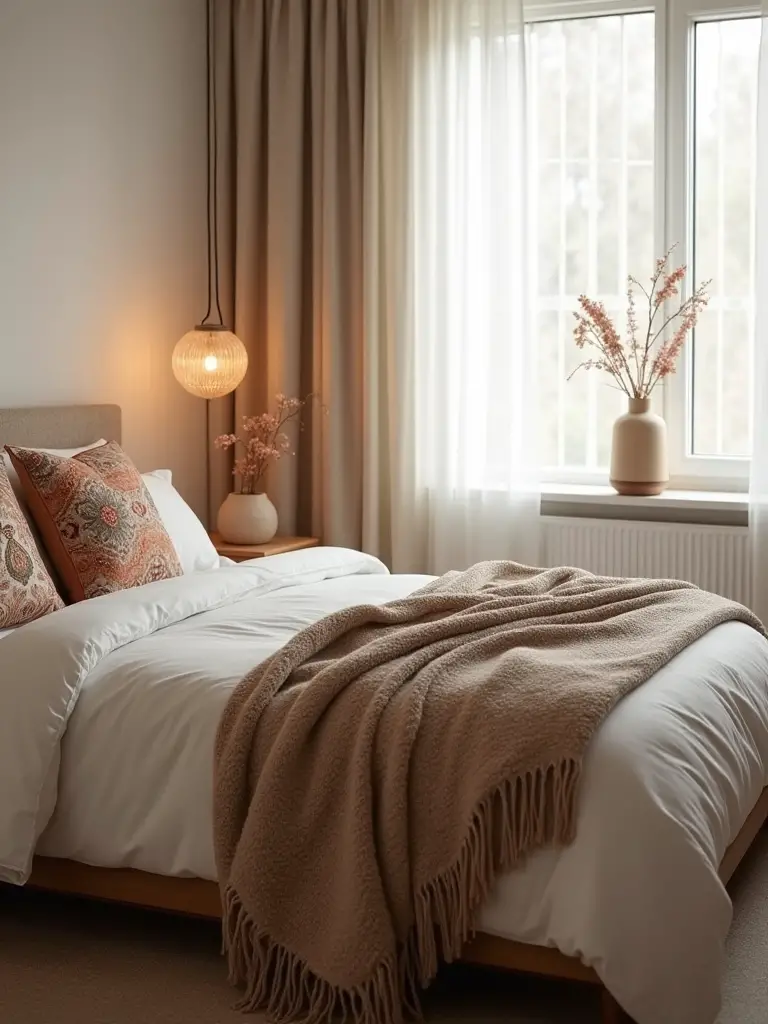
Keep a core set of neutral, timeless pieces and have a small, curated collection of seasonal accents. I suggest storing them in a single, clearly labeled bin. This small ritual keeps you engaged with your space, makes you appreciate the changing seasons, and ensures your cozy haven always feels fresh and inspiring.
We’ve covered the design, the styling, and the systems. There is only one thing left, and it is perhaps the most crucial: how you interact with the space you’ve created.
Maintaining the Cozy Charm: Daily Habits & Advanced Touches (Part 2)
The final piece of the puzzle isn’t something you can buy. It’s a practice. It’s about consciously using the space you’ve designed to signal to your body and mind that the day is done, and it’s time for rest.
21. Establish a Nightly Ritual to Embrace Your Cozy Space
Your beautiful, cozy bedroom is the stage; your nightly ritual is the performance. A consistent wind-down routine is the activation key for your sanctuary. This is your personal sequence of events that tells your brain, “We are entering rest mode now.”

Thirty minutes before you want to sleep, turn off all screens. Dim the lights. Put on some calming music. Make a cup of herbal tea. Read a few pages of a physical book. Tidy your nightstand for the morning. Whatever your ritual is, be consistent. This simple, mindful practice is what truly transforms your bedroom from a collection of well-designed objects into a cherished, restorative retreat that serves you night after night.
Conclusion
Creating a bedroom that is a true sanctuary is one of the most rewarding investments you can make in your well-being. It’s not about following fleeting trends or a specific style; it’s about a thoughtful, layered approach to building comfort from the ground up. By focusing on a solid foundation, curating quality core elements, infusing the space with your personal story, and maintaining it with intention, you create more than just a cozy room. You create a haven that supports your rest, calms your mind, and genuinely feels like home.
So, where do you begin? Don’t try to do it all at once. Pick one strategy from this list that excites you the most—maybe it’s finally upgrading your bedding or finding the perfect warm-toned table lamps. Start there. Every small, deliberate choice is a step toward crafting the personal, deeply comforting retreat you deserve.
